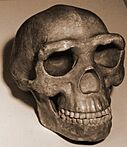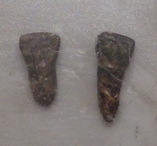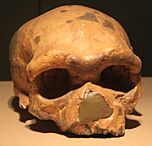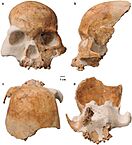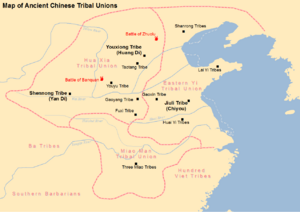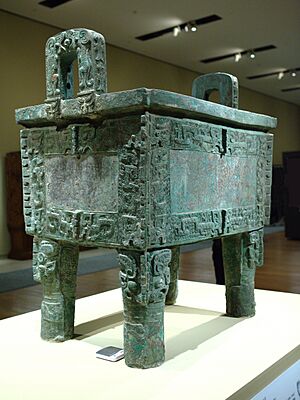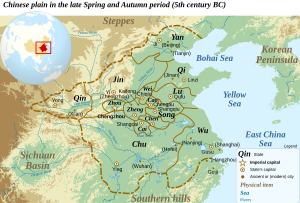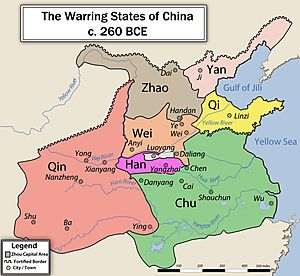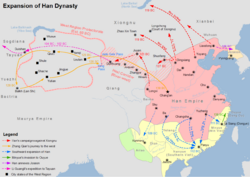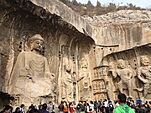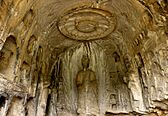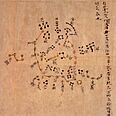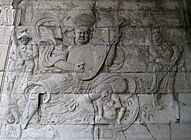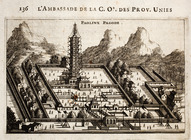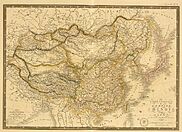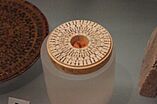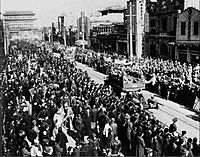History of China facts for kids
The history of China is one of the oldest in the world, going back thousands of years. Chinese civilization grew up along the Yellow River and Yangtze River. Over its long history, China has been home to many different groups of people and has gone through times of being a single, powerful empire and times of being divided into smaller kingdoms.
A common way to look at Chinese history is through its dynasties. A dynasty is a period of time when a country is ruled by members of the same family. When one dynasty fell, another would rise to take its place. This is called the dynastic cycle. This long, continuous history makes China one of the cradles of civilization.
The story of China begins in the Stone Age, with the rise of early farming villages. The first dynasty in traditional stories is the Xia dynasty, but the first one with written proof is the Shang dynasty. Around 1250 BC, the Shang people wrote on oracle bones, which are the earliest examples of written Chinese.
In 221 BC, China was united for the first time by Qin Shi Huang, the first emperor. This was the start of Imperial China, which lasted for over 2,000 years. The Han dynasty that followed is considered a golden age. The main ethnic group in China is called Han Chinese because of this dynasty. During this time, Confucianism became a very important philosophy.
Later dynasties like the Tang dynasty and Song dynasty were also golden ages. They were known for amazing art, poetry, and inventions like printing and gunpowder. In the 13th century, the Mongol Empire conquered China and started the Yuan dynasty. After them, the Ming dynasty built famous landmarks like the Forbidden City and rebuilt much of the Great Wall of China.
The last dynasty was the Qing dynasty, which was ruled by the Manchu people. In the 19th century, China had conflicts with European countries over trade. In 1911, a revolution ended the Qing dynasty and the Republic of China was created.
After World War II, a civil war was fought between the Nationalists and the Communists. The Communists, led by Mao Zedong, won and established the People's Republic of China (PRC) on the mainland in 1949. The Nationalist government moved to the island of Taiwan. Since then, China has grown to become one of the most powerful countries in the world.
Contents
Prehistory: The Earliest People in China
The Stone Age
The earliest known humans in China, a type called Homo erectus, lived there as far back as 1.7 million years ago. One of the most famous examples is the Peking Man, who lived near modern Beijing between 700,000 and 400,000 years ago. These early people made simple stone tools like choppers and scrapers. They also learned how to use fire.
Modern humans, or H. sapiens, appeared in China around 100,000 years ago. They lived alongside large animals like giant pandas, hyenas, and ancient elephants called Stegodon.
The Neolithic Age: The Start of Farming
Around 10,000 years ago, people in China began to farm. This was the start of the Neolithic Age, or New Stone Age. Along the Yangtze River, people grew rice. Along the Yellow River, they grew a grain called millet. The Jiahu site is an example of an early farming village.
With farming, the population grew. People could store food, which allowed some people to become craftsmen or leaders. At sites like Jiahu, archaeologists have found early symbols that might be a form of proto-writing. People also began to raise animals like pigs and dogs.
The Bronze Age
The Bronze Age began in China around 3100 BC. People learned how to mix copper and tin to create a strong metal called bronze. They used it to make weapons, tools, and beautiful ritual vessels.
A mysterious Bronze Age culture was discovered at Sanxingdui in Sichuan province. Archaeologists found amazing bronze masks and statues that look very different from those in other parts of China. This shows that ancient China had many different cultures.
Ancient China: The First Dynasties
In ancient times, China was not always one single country. Different states and cultures existed at the same time. The earliest stories tell of wise rulers like Yao, Shun, and Yu the Great. Yu is said to have founded the first dynasty.
Xia Dynasty (c. 2070 – c. 1600 BC)
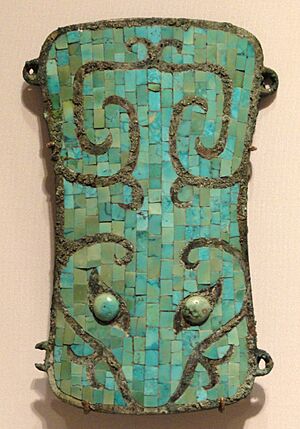
The Xia dynasty is the first dynasty mentioned in old Chinese history books. For a long time, historians were not sure if it was real or just a myth. However, archaeologists have found a site at Erlitou that might have been the capital of the Xia. They found palaces and bronze workshops, which suggests it was an organized state. But since no writing was found, we can't be certain it was the Xia.
Shang Dynasty (c. 1600 – c. 1046 BC)
The Shang dynasty is the first Chinese dynasty that we have clear proof for. Archaeologists have found the ruins of their last capital city at Yinxu, near Anyang. There, they discovered thousands of animal bones and turtle shells with writing on them.
These are called oracle bones. The Shang kings used them to ask questions to the gods about things like war, harvests, and the future. The writing on these bones is the earliest form of Chinese characters. The Shang were also masters of bronze casting, creating detailed vessels for religious ceremonies.
Zhou Dynasty (1046–256 BC)
The Zhou dynasty was the longest-lasting dynasty in Chinese history. They defeated the Shang and took control of the Yellow River valley. To justify their rule, the Zhou kings introduced the idea of the Mandate of Heaven.
This idea said that the ruler of China was chosen by Heaven (the gods). A good and fair ruler would have the Mandate of Heaven. But if a ruler became cruel or incompetent, Heaven would show its displeasure with disasters like floods or earthquakes. Then, the people had the right to overthrow him, and a new dynasty would receive the Mandate. This idea was used by Chinese dynasties for the next 3,000 years.
Spring and Autumn Period (722–476 BC)
After a few hundred years, the Zhou kings lost much of their power. Their kingdom broke up into many small states that were loyal to the king in name only. This time is called the Spring and Autumn period.
The states began to fight each other for land and power. During this chaotic time, some of the most important thinkers in Chinese history lived. This included Confucius, who taught about respect, family, and good government, and Laozi, who founded Taoism. Their ideas would shape Chinese culture for centuries.
Warring States Period (476–221 BC)
The fighting between the states grew even more intense. Over time, the smaller states were conquered by larger ones, until only seven major states were left. This era is known as the Warring States period.
The states developed new technologies for war, like iron weapons and crossbows. They also built large armies and better governments to manage their resources. In the end, the state of Qin in the west became the most powerful. Its leader, Ying Zheng, conquered all the other states one by one.
Imperial China: An Empire United
The imperial era lasted for more than 2,000 years, from the unification of China under the Qin dynasty to the fall of the Qing dynasty in 1912.
Qin Dynasty (221–206 BC)
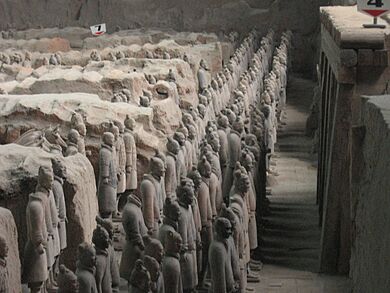
In 221 BC, Ying Zheng of Qin united China and became its first emperor. He gave himself the title Qin Shi Huang, which means "First Emperor of Qin." He created a strong central government and divided the country into provinces run by officials he chose.
To unite his new empire, Qin Shi Huang standardized many things. He made everyone use the same writing system, the same money, and the same weights and measures. He also ordered the building of a huge network of roads. To protect China from northern tribes, he connected existing walls to form the first version of the Great Wall of China.
The emperor was also famous for his massive tomb, which is guarded by thousands of life-sized clay soldiers called the Terracotta Army. However, his rule was very strict, and his dynasty did not last long after his death.
Han Dynasty (206 BC – AD 220)
The Han dynasty was founded by Liu Bang and is considered one of China's greatest golden ages. It lasted for over 400 years and was a time of peace and prosperity. The Han expanded China's territory and established the Silk Road, a network of trade routes that connected China to Central Asia and even the Roman Empire.
During the Han dynasty, Confucianism became the official philosophy of the government. To become a government official, a person had to pass exams on Confucian teachings. This period also saw many important inventions, including papermaking, which made it easier to spread knowledge. The influence of this dynasty was so great that the main ethnic group in China is still called the Han Chinese.
A Time of Division (AD 220–581)
After the Han dynasty fell, China entered a period of nearly 400 years of disunity. This era began with the famous Three Kingdoms period, where the states of Wei, Shu, and Wu fought for control.
Later, China was split into a northern and a southern part. The north was ruled by a series of non-Han Chinese peoples, while the south was ruled by Han Chinese dynasties. During this time, Buddhism, which had come from India along the Silk Road, became very popular in China.
Sui and Tang Dynasties: A New Golden Age
Sui Dynasty (581–618)
The Sui dynasty reunited China in 589. Although it was short-lived, it made important changes. The Sui emperors rebuilt the Great Wall and constructed the Grand Canal. This huge waterway linked northern and southern China, making it easier to transport grain and goods. However, these massive projects and costly wars exhausted the people, and the dynasty was soon overthrown.
Tang Dynasty (618–907)
The Tang dynasty is often called the second golden age of China. It was a time of great cultural achievement, especially in poetry. The capital city, Chang'an (modern Xi'an), was the largest city in the world and was home to people from many different countries.
The Tang empire was powerful and its influence spread across Asia. Trade along the Silk Road flourished, bringing new ideas and goods to China. Buddhism was very important during this time. The Tang dynasty was also home to China's only female emperor, Wu Zetian. A major rebellion in the mid-8th century weakened the dynasty, and it eventually collapsed.
Song Dynasty: A Time of Invention
After another period of division, the Song dynasty reunited China in 960. The Song was militarily weaker than the Tang and had to fight powerful empires to the north. However, it was a time of incredible economic growth and technological innovation.
During the Song dynasty, the Chinese invented movable-type printing, which made books cheaper and more available. They were the first to use gunpowder in weapons like rockets and bombs. They also created the world's first paper money. The Song dynasty had a large navy and was a major sea power.
Yuan Dynasty: The Mongol Rule
In the 13th century, the Mongols, led by Genghis Khan, began their conquest of Asia. His grandson, Kublai Khan, completed the conquest of China and founded the Yuan dynasty in 1271. This was the first time that all of China was ruled by foreigners.
The Mongols ruled a huge empire, and for a time, the Silk Road was safe for travel. This allowed for more contact between China and the rest of the world. The most famous European traveler to visit China during this time was Marco Polo from Venice. The Mongols adopted some Chinese customs, but many Han Chinese were unhappy with their rule.
Ming Dynasty (1368–1644)
In 1368, a Chinese peasant leader named Zhu Yuanzhang led a rebellion that drove the Mongols out of China. He founded the Ming dynasty. The Ming emperors built the magnificent Forbidden City in Beijing and rebuilt much of the Great Wall of China to the form we see today.
In the early Ming dynasty, the admiral Zheng He led seven huge naval expeditions. His "treasure fleets" sailed across the Indian Ocean, reaching as far as the coast of Africa. These voyages showed China's power but were stopped after the emperor's death. Later in the dynasty, European traders, like the Portuguese, began to arrive in China by sea.
Qing Dynasty (1644–1912)
The Qing dynasty was the last imperial dynasty of China. It was founded by the Manchu people from the northeast, who conquered the Ming dynasty. Under the Qing, the Chinese empire expanded to its largest size, including Taiwan, Mongolia, and Tibet.
In the 19th century, the Qing dynasty began to weaken. European powers, especially Britain, wanted to increase trade with China. This led to conflicts like the Opium Wars. China lost these wars and was forced to sign treaties that gave up control of ports like Hong Kong to Britain. Internally, the massive Taiping Rebellion further weakened the government. By the early 20th century, many Chinese people wanted change.
Modern China
Republic of China (1912–1949)
In 1911, the Xinhai Revolution broke out. The last emperor stepped down, and in 1912, the Republic of China was established. Sun Yat-sen, a revolutionary leader, is often called the "Father of Modern China."
However, the new republic was weak and soon fell into a period known as the Warlord Era, where military leaders controlled different parts of the country. In the 1920s, the Nationalist Party (KMT), led by Chiang Kai-shek, tried to reunite China.
The KMT also fought with the growing Chinese Communist Party (CCP). The two sides were in a civil war when Japan invaded China in 1937. The Nationalists and Communists formed a temporary alliance to fight the Japanese during World War II.
A Divided Nation (since 1949)
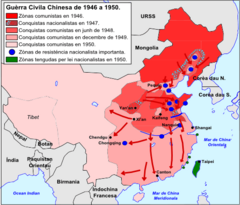
After Japan was defeated in 1945, the civil war between the KMT and the CCP started again. The Communists, led by Mao Zedong, gained the support of many peasants and eventually won.
People's Republic of China
On October 1, 1949, Mao Zedong proclaimed the founding of the People's Republic of China (PRC) in Beijing. The KMT government, led by Chiang Kai-shek, fled to the island of Taiwan.
Under Mao, China went through major changes. The government took control of land and businesses. Campaigns like the Great Leap Forward and the Cultural Revolution were meant to modernize China but caused great hardship and turmoil for millions of people.
After Mao's death in 1976, Deng Xiaoping became the leader. He introduced economic reforms that opened China to the rest of the world. These reforms led to decades of rapid economic growth. Today, China is a major economic and political power. In recent years, there have been international concerns about the treatment of the Uyghur people, a minority group in the Xinjiang region. The Chinese government has stated its actions are for security and development, but other countries have expressed disagreement.
Republic of China (Taiwan)
The Nationalist government (KMT) continued to rule on Taiwan as the Republic of China. For many years, it was a one-party state with the goal of retaking the mainland. In the 1980s and 1990s, Taiwan transformed into a democracy. Today, it is known for its advanced technology industry. The political status of Taiwan remains a complex issue.
-
The People's Liberation Army enters Beijing in 1949.
See also
 In Spanish: Historia de China para niños
In Spanish: Historia de China para niños
- Chinese exploration
- Chinese historiography
- Christianity in China
- Economic history of China
- Ethnic groups in Chinese history
- Foreign relations of imperial China
- Golden ages of China
- History of canals in China
- History of Islam in China
- History of science and technology in China
- History of Taiwan
- History of the Great Wall of China
- List of Chinese monarchs
- List of rebellions in China
- Military history of China before 1912
- Naval history of China
- Population history of China
- Timeline of Chinese history
- Women in ancient and imperial China



